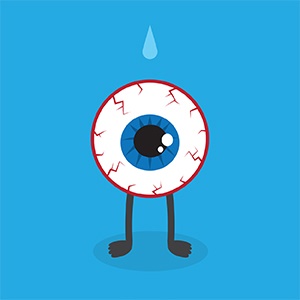
Dry eye syndrome; a sight for sore eyes that will make you put your phone down and literally have you in tears.
This rather unfamiliar condition is synonymous with red, itchy eyes and is becoming more widespread in the digital age. As we spend more time in front of screens, we place unnecessary strain on our eyes as we jump from our computers to our phones to our televisions.
Dry eye syndrome is predominantly caused by a lack of moisture in the eye, dust particles in the air and infrequent blinking which usually happens when you stare at a screen for too long.
Understanding dry eye would be a lot easier if we thoroughly understood normal tear function. To date, many aspects of tear function remain poorly understood. But what we do know is that it’s important not to turn a blind eye to this condition, because it may scar your cornea or lead to conjunctivitis.
Here are a few things you need to know about dry eye syndrome:
What is dry eye syndrome?
Dry eye is a term used to describe a group of different diseases and conditions affecting one or more components of the lacrimal system. The lacrimal apparatus is the part(s) of the eye that work together to produce tears and ensure drainage.
There are two types of dry eye syndromes namely aqueous tear-deficient dry eye and evaporative dry eye.
Aqueous tear-deficient dry eye is a disorder in which the lacrimal glands fail to produce enough of the watery component of tears to maintain a healthy eye surface.
Evaporative dry eye may result from inflammation of the meibomian glands, also located in the eyelids. These glands make the lipid or oily part of tears that slows evaporation and keeps the tears stable.
Symptoms of dry eye syndrome may include one or more of the following:
- Burning eyes.
- Redness of the eye.
- A feeling as if something is in the eye.
- Discharge from the eye.
- Excessive tears following very dry eye periods.
- Episodes of blurred vision.
- Heavy eyelids.
Are you at risk?
Although elderly people frequently experience dry eyes, it can occur at any age. For women, dry eye is even more common after menopause. But despite biological factors like age and gender, there are loads of other factors that can cause dry eye syndrome like dust particles in the air and sitting in front of a screen for too long.
To prevent developing dry eyes, avoid dry conditions and allow your eyes to rest when performing activities that require you to use your eyes for long periods of time. Glasses or sunglasses that fit close can help slow tear evaporation from the eye surfaces. Indoors, a humidifier may also help by adding moisture to the air.
Treatment
For mild cases (from reading, computer use and schoolwork), the general treatment is artificial tears or other lubricating eye drops. For long-term solutions, punctal plugs help tears remain on the surface of the eye longer. A punctal plug is a small, sterile device that’s inserted into one of the small openings that are located in the inner corner of the upper and lower eyelids. After these openings have been plugged, tears can no longer drain away from the eye through these ducts. In this way the tear stays intact on the surface of the eye for longer, relieving dry eye symptoms.





 Publications
Publications
 Partners
Partners











